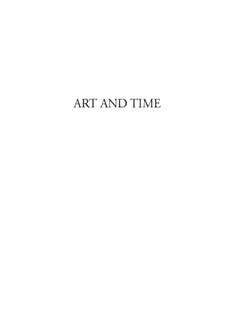
Art and time PDF
Preview Art and time
ART AND TIME ART AND TIME Edited by Jan Lloyd Jones Paul Campbell Peter Wylie Australian Scholarly Publishing In memory of Iain Wright (1944–2006) Professor of English at The Australian National University and Life Fellow of Queens’ College, Cambridge © Jan Lloyd Jones, Paul Campbell & Peter Wylie 2007 First published 2007 Australian Scholarly Publishing Pty Ltd 7 Lt Lothian St Nth, North Melbourne, Vic 3051 Tel: 03 9329 6963 Fax: 03 9329 5452 Email: [email protected] Web: www.scholarly.info A Cataloguing-in-Publication entry for this title is available from the National Library of Australia. ISBN 9781740971737 All Rights Reserved Design and typesetting by Adam Bextream Printing and binding by the BPA Group, Melbourne Cover Photograph: Winged Victory of Samothrace. Photograph: Derek Allan CONTENTS Acknowledgements ix Preface x Introduction Art, Time and Metamorphosis, Derek Allan 1 Philosophy Time in Philosophy and Art, Simon Haines 13 Art, Eternity, Aevum, Time, Sixto J. Castro 31 Hermeneutics, Historicity, and Poetry as Theological Revelation in Dante’s Divine Comedy, William Franke 39 Dynamic Sensation: Bergson, Futurism and the Exteriorization of Time in the Plastic Arts, Paul Atkinson 57 Literature Proust’s Artists and Anachronisms, James Grieve 75 New Historicism, Hamlet and Time, Duncan Driver 97 A Diary of the Young Man as an Artist, Stephen McLaren 114 The Operation of Time in Tennessee Williams’ The Glass Menagerie, Geoffrey Borny 131 Time’s Wallet: The Poetics of Time: An Anthology, Ralph Elliott 145 Fantasy and Life-Writing Tolkien and Time: The Fantastic Art of Consolation, Endurance, Escape, Alison Searle 158 Paradoxes and Hypodoxes of Time Travel, Peter Eldridge-Smith 172 vii Art and Time Retrieving the Past, Transforming the Future: Time and Art in Autobiographies of Childhood and Incarceration, Susan Tridgell 190 Time, Inertia and the Medical Cyborg: Jean-Dominique Bauby’s The Diving Bell and the Butterfly, Bjorn Nansen 207 Architecture and Painting Elegy and Politics in Islamic Attitudes to Architecture, Michael Greenhalgh 224 Angels in the Architecture: Augustine, Art and Time, Stephen Frith 240 New Ideas of Wonder: Haptic Time in Organic Architecture, Andrew Macklin 256 “À toutes les heures, par tous les temps”: Impressionist Landscapes and Capturing Time, Emilie Sitzia 273 Music Time’s Music, Albert Mayr 285 Dance and Time in Fifteenth-Century Italy, Jennifer Nevile 299 Music and the Experience of Timelessness, Brian Luke 314 Editors and Contributors 333 viii Acknowledgements The editors gratefully acknowledge the support of the Australian National University through the Publications Committee, the Faculty of Arts, and the School of Humanities. Thanks are also due to Derek Allan, Amanda Crawford, Scott Fuller, Julian Lamb, Paul Miller, and Susan Tridgell for their generous assistance in this project. Many of the papers in this volume were first presented at the Art and Time symposium held in the School of Humanities at the Australian National University in November 2005. ix Preface In late 2005, the School of Humanities at the Australian National University convened a conference on the topic of “Art and Time”. The conference was interdisciplinary in approach, inviting speakers from a range of fields in the humanities. It attracted a wide array of contributors from universities throughout Australia as well as from the United States, Asia, and Europe. This volume presents a selection of papers from the conference, together with a number of papers invited from other scholars with an interest in the topic. The papers are divided into five sections: Philosophy, Literature, Fantasy and Life-Writing, Architecture and Painting, and Music. The Philosophy section begins with Simon Haines, who, in a sweeping overview of what philosophers from Heraclitus to Huw Price have had to say on the subject of time, compares flow theories with block theories, A series with B series time, chronos (measurable time) with kairos (timeliness, seasonableness), and subjective and objective notions of time. He then contrasts these insights offered by the philosophers with those of the poets, covering a similarly impressive expanse of time. Also in this section, Sixto J. Castro, working with ideas from Aristotle, Aquinas and Gadamer, compares notions of time and eternity and their relation to our understanding of the work of art; William Franke uses Gadamerian hermeneutics to understand the representation of suprahistorical truth in Dante’s La Divina Commedia; and Paul Atkinson takes a Bergsonian perspective on the Italian Futurist painters’ attempts to capture the dynamism of the moment and make time visible in art. x
